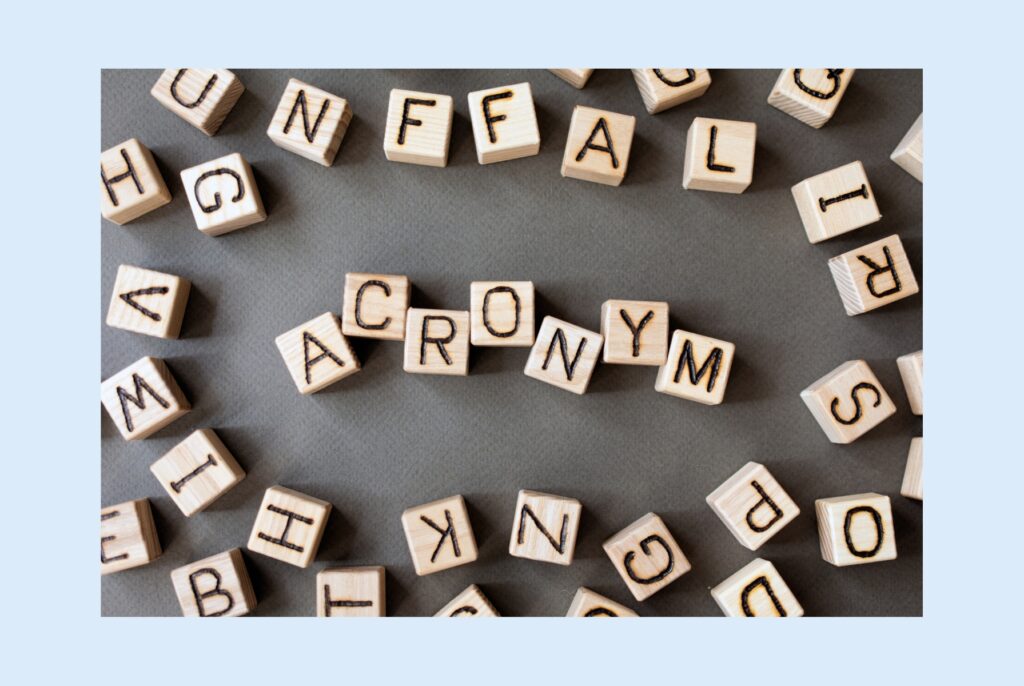Have you ever seen a social media post that looks like it needs a translator? Hashtags flying everywhere, comments mentioning CTRs and SMNPs… it’s like another language!
Need help? Don’t worry, you’re not alone. This blog is your secret weapon to cracking the social media management code. We’ll translate all that confusing jargon and trending slang, from figuring out how to measure campaign success (think dollar signs!) to what those mysterious hashtags mean (#FOMO, anyone?).
Think ELI5 (Explain Like I’m Five) for grown-ups wanting to dominate social media. The goal is to keep it clear, concise, and (hopefully) entertaining!
Forget the dictionary; bookmark this blog instead. We'll turn you into a social media pro faster than you can say "hashtag.”
Let’s make you more confident about conquering the social media code.
Table of contents
- Why do businesses use acronyms?
- List of 100+ common social media acronyms examples used in daily business communication
- 40 common GEN Z social media slang text acronyms
- Top 10 trending social media slang of all time
- 50+ social media acronyms used by businesses across industries and professions
- Social media acronyms most commonly used by customer service experts
- Social media acronyms most popular in the advertising industry
- Technical social media acronyms
- Analytical acronyms most commonly used in social media
- Social media acronyms used by video marketing professionals
- Event marketing-specific social media acronyms
- Finance & accounting acronyms most used in social media
- Project management social media acronyms
- Social media acronyms that Human Resources professionals use
- Social media acronym most popular among lawyers and in the legal industry
- Most common social media acronym for work and new technologies
- Master social media’s non-verbal language with these acronyms and slang
- FAQs on social media acronyms examples
- Dominate social media management with Birdeye Social
What's an acronym? An acronym is an abbreviation formed by taking the initial letters of a phrase or word sequence and pronouncing them as a word (like "NASA" for the National Aeronautics and Space Administration).
Why do businesses use acronyms?
Businesses use acronyms for several reasons, some with advantages and some with drawbacks. Here’s a breakdown of the pros and cons:
Pros of using social media acronyms for businesses:
- Save time & space: Social media acronyms shorten lengthy phrases when writing and speaking. This is especially helpful in fast-paced environments like internal communication or social media.
- Improving efficiency: Using a shared vocabulary within a company leads to faster decision-making and clearer instructions when everyone understands the meaning.
- Create a sense of community: Creating a community fosters a sense of belonging and shared knowledge within a team or field.
- Brand recognition: Some well-established acronyms can become synonymous with the company or product they represent (e.g., IBM, NASA).

Cons of using social media acronyms for businesses:
- Confusion for newcomers: Newcomers or those unfamiliar with the industry. They may feel left out or need clarification on the constant use of abbreviations.
- Misunderstandings: if acronyms aren’t clearly defined or have multiple meanings, confusion and misinterpretations can arise, impacting communication and potentially leading to errors.
- Overreliance on acronyms: Overusing acronyms can alienate external audiences (customers, partners) who may not be familiar with the jargon.
- Loss of clarity: Acronyms can sometimes obscure the original meaning of the phrase they represent.
That is why businesses must weigh all these pros and cons and use acronyms in their business communications effectively.
So, how can you use acronyms contextually?
Here are some tips:
✅Context is key: Pay attention to the surrounding conversation to understand the meaning of an unfamiliar acronym.
✅Don’t be shy: If unsure, politely ask for clarification. Most people are happy to explain acronyms.
✅Embrace learning: Gradually build knowledge of common acronyms used in your field.
Now, let’s take a look at some common acronyms.
List of 100+ common social media acronyms examples used in daily business communication
The following sections provide a glimpse into the vast world of acronyms, categorized by common business and professional fields.
Social media acronyms for different platforms
Streamline your social media conversations with the following acronyms used to refer to various platforms:
- FB – Facebook
- IG – Instagram
- TW – Twitter
- LI – LinkedIn
- YT – YouTube
- TT – TikTok
- SC – Snapchat
- P – Pinterest
- WA – WhatsApp
- RD – Reddit
- WC – WeChat
Social media acronyms for engagement
Using the following acronyms for social media engagement can help you better connect with the younger audience and make you look up-to-date.
- F4F – Follow for Follow: (Encourages mutual following for increased visibility)
- L4L – Like for Like: (Promotes reciprocal liking to boost engagement)
- S4S – Share for Share: (Encourages mutual content sharing to expand reach)
- IMHO – In My Humble Opinion: (Sharing personal views to engage audiences)
- ICYMI – In Case You Missed It: (Highlights important updates or content)
- BTW – By The Way: (Introduces additional information or updates)
- TBT – Throwback Thursday: (Posts nostalgic content to increase engagement)
- FWIW – For What It’s Worth: (Offers opinions or advice to the audience)
- QOTD – Quote of the Day: (Shares daily inspirational or motivational quotes)
- OOTD – Outfit of the Day: (Showcases daily attire to engage fashion followers)

General business social media acronyms
Mastering the following business acronyms will help you make clear and efficient communication across all interactions.
- B2B – Business to Business: (Marketing or sales aimed at other businesses)
- B2C – Business to Consumer: (Marketing or sales aimed at individual customers)
- Ecommerce – Electronic Commerce: (Online buying and selling of goods)
- UX – User Experience: (Designing products/services for optimal user experience)
- AI – Artificial Intelligence: (Machine learning and intelligent automation)
- BPO – Business Process Outsourcing: (Contracting specific business functions to a third party)
- SME – Subject Matter Expert: (An individual with deep knowledge in a specific area) [e.g., Consulting the SME for detailed insights]
- SMB – Small and Medium-sized Businesses: (Businesses with limited revenue and number of employees) [e.g., Offering tailored solutions for SMB growth]
- CMGR – Community Manager: (Manages online communities to foster engagement)
- CMS – Content Management System: (Software for creating and managing content)
- CRM – Customer Relationship Management: (Manages company’s interactions with customers)
- CRO – Conversion Rate Optimization: (Improves the percentage of conversions)
- DM – Direct Message: (Private messaging between users on social media)
- KPI – Key Performance Indicator: (Measurable value to gauge performance)
- PPC – Pay Per Click: (Advertiser pays for each click on their ads)
- SWOT – Strengths, Weaknesses, Opportunities, Threats: (Framework for analyzing business strategies)
- CEO – Chief Executive Officer: (Top executive responsible for overall operations)
- CFO – Chief Financial Officer: (Executes financial strategies and operations)
- COO – Chief Operating Officer: (Oversees day-to-day administrative operations)
- CMO – Chief Marketing Officer: (Oversees marketing strategies and initiatives)
- HR – Human Resources: (Manages employee relations and resources)
- IT – Information Technology: (Manages technology and systems)
- QA – Quality Assurance: (Ensures products meet quality standards)
- R&D – Research & Development: (Develops new products and improvements)
- M&A – Mergers & Acquisitions: (Combines companies or assets)
- COB – Close of Business: (End of the business day)
Common social media marketing acronyms
This section will be your cheat sheet for the most essential marketing and sales acronyms you’ll encounter on social media:
- SMM – Social Media Marketing: (Using social media to promote products/services)
- SMP – Social Media Platform: (Platforms used for social networking)
- UGC – User-Generated Content: (Content created by users, not brands)
- SEO – Search Engine Optimization: (Improves website visibility in search engines)
- SEM – Search Engine Marketing: (Uses paid ads to appear in search results)
- SMO – Social Media Optimization: (Improves content visibility on social media)
- ASAP – As Soon As Possible: (Urgent task completion)
- LTD – Lead Time Distribution: (Measures the time taken for processes)
Decoding Facebook Messenger icons and symbols
Work and professional social media acronyms
Unsure what your colleagues’ B2Bs and TBDs mean? Don’t worry! This section transforms you from an office newbie to a jargon-savvy pro, ready to conquer meetings, emails, and water cooler talk. Let’s look at some common work acronyms:
- FYI – For Your Information: (Shares information without requiring action) [e.g., Sending an FYI email to update team]
- IMO – In My Opinion: (Expresses personal view on a topic) [e.g., Sharing feedback with IMO in a meeting]
- NRN – No Reply Necessary: (Indicates no response needed) [e.g., Ending an update with NRN to save time]
- OOO – Out Of Office: (Indicates unavailability due to absence) [e.g., Setting an OOO reply for vacation]
- PFA – Please Find Attached: (Notifies of attached documents) [e.g., Sending a report with PFA in the email]
- TBD – To Be Decided: (Indicates pending decisions) [e.g., Marking agenda items as TBD]
- TMI – Too Much Information: (Indicates excess detail) [e.g., Using TMI to request concise updates]
- YOY – Year Over Year: (Compares annual performance metrics) [e.g., Analyzing YOY growth in reports]
- YTD – Year-to-Date: (Measures performance from the year’s start) [e.g., Reviewing YTD sales figures]
- TOS – Terms of Service: (Outlines rules and regulations) [e.g., Agreeing to TOS before service use]
- SOV – Share of Voice: (Measures brand presence in the market) [e.g., Increasing SOV through targeted ads]
- SSO – Single Sign-On: (Allows one login for multiple applications) [e.g., Implementing SSO for ease of access]
Social media texting acronyms your customers expect you to know

This section deciphers the most common social media texting acronyms. Mastering the following abbreviations will help you better understand your customers, respond faster, and build stronger relationships.
- PM – Private Message: (Direct messaging between users) [e.g., Using PM for confidential conversations]
- RT – Retweet: (Shares someone else’s tweet) [e.g., RT industry news to followers]
- DND – Do Not Disturb: (Indicates unavailability) [e.g., Setting DND during focus work]
- GR8 – Great: (Expresses approval or satisfaction) [e.g., Responding with GR8 to positive news]
- HBD – Happy Birthday: (Birthday greeting) [e.g., Posting HBD on colleague’s profile]
- L8R – Later: (Indicates future communication) [e.g., Saying L8R in casual sign-offs]
- NP – No Problem: (Indicates agreement or no issue) [e.g., Responding NP to requests]
- PPL – People: (Refers to individuals or groups) [e.g., Addressing PPL in team communications]
- TBA – To Be Announced: (Pending announcement) [e.g., Marking dates as TBA in events]
- TTYS – Talk To You Soon: (Ends conversation) [e.g., Closing messages with TTYS]
- YW – You’re Welcome: (Response to thanks) [e.g., Replying YW in gratitude exchanges]
- MFW – My Face When: (Expresses reactions) [e.g., Using MFW memes in marketing]
- RTFM – Read The * Manual: (Directs to instructions) [e.g., Replying RTFM for troubleshooting]
- IIRC – If I Recall Correctly: (Indicates uncertainty) [e.g., Prefacing statements with IIRC]
- IDGAF – I Don’t Give A *: (Expresses indifference) [e.g., Using IDGAF in casual chats]
- NVM – Never Mind: (Dismisses previous statement) [e.g., Saying NVM to cancel requests]
- SMH – Shaking My Head: (Expresses disappointment) [e.g., Using SMH to show disapproval]
- TBH – To Be Honest: (Expresses frankness) [e.g., Prefacing opinions with TBH]
- WYD – What You Doing?: (Inquires about activity) [e.g., Starting conversations with WYD]
- TBC – To Be Continued: (Indicates ongoing discussion) [e.g., Ending updates with TBC]
- TY – Thank You: (Expresses gratitude) [e.g., Closing emails with TY]
- TYVM – Thank You Very Much: (Expresses deep gratitude) [e.g., Using TYVM in acknowledgments]
- OMG – Oh My God: (Expresses surprise) [e.g., Reacting to the news with OMG]
- GTG – Got to Go: (Indicates departure) [e.g., Ending chats with GTG]
- WTH – What The Heck: (Expresses confusion) [e.g., Responding to surprises with WTH]
- BFN – Bye For Now: (Temporary goodbye) [e.g., Signing off with BFN]
- CU – See You: (Saying goodbye) [e.g., Closing chats with CU]
- NGL – Not Gonna Lie (Expresses honesty) [e.g., NGL, this proposal needs more work.]
- HAND – Have A Nice Day: (Used to wish someone well) [e.g., Signing off an email with HAND]
- TTYL – Talk To You Later: (Sign off indicating future communication) [e.g., “Great meeting today. TTYL!”]
- IDC – I Don’t Care: (Expresses indifference) [e.g., “IDC what others say, I believe in our product.”]
- LMAO – Laughing My A** Off: (Expresses extreme amusement) [e.g., “That outtake video was hilarious, LMAO!”]
- FTW – For The Win: (Highlights success or achievement) [e.g., “Our latest campaign, FTW!”]
- IDK – I Don’t Know: (Expresses uncertainty) [e.g., “IDK the exact figures, but sales are up.”]
Content creation acronyms social media creators use the most
Social media content creation is all about engaging with your audience, keeping up with trends, and speaking their language. Let’s unravel some common acronyms used in this space:
- P2P – Peer to Peer: Connecting directly with followers (e.g., Hosting a Q&A session with your audience)
- EOD – End of Day: Deadlines or status updates (e.g., “Finished filming content for EOD!”)
- EOW – End of Week: Content planning or goal updates (e.g., “Reviewing content performance for EOW report”)
- IDK – I Don’t Know: Engaging with audience questions (e.g., “IDK about that filter, IMO…” )
- IMO – In My Opinion: Sharing personal thoughts or reviews (e.g., “This new camera is IMO a game-changer!”)
- YOLO – You Only Live Once: Lighthearted content or brand philosophy (e.g., “YOLO, let’s try this crazy recipe!”)
- BRB – Be Right Back: Short breaks during content creation (e.g., “BRB, grabbing coffee before filming the next scene”)
- BTS – Behind the Scenes: Exclusive content for follower engagement (e.g., Sharing BTS bloopers from a photoshoot)
- DYK – Did You Know?: Educational or informative content (e.g., “DYK this editing trick can save you time?”)
- ETA – Estimated Time of Arrival: Teasing upcoming content (e.g., “New video ETA: next week!”) [Building anticipation]
- AFAIK (As Far As I Know): A disclaimer used when sharing uncertain information. (e.g., “AFAIK, the new restaurant opens next week.”)
- FYI (For Your Information): Used to share something you think someone might find useful. (e.g., “FYI, the meeting time has been changed.”)
- TL;DR (Too Long; Didn’t Read): Summarizes lengthy content or indicates you haven’t read it all. (e.g., “Can someone give me the TL;DR of that article?”)
40 common GEN Z social media slang text acronyms

While serving Gen Z customers, understanding their lingo helps you create resonant content, respond confidently, and build stronger customer relationships. Here are the most common GEN Z social media slang text abbreviations acronyms:
- SMH – Shaking My Head: Disapproval, disappointment, or disbelief. (e.g., Using SMH in response to frustrating news)
- GOAT – Greatest Of All Time: Superlative praise for someone or something. (e.g., Referring to a favorite celebrity as GOAT)
- SUS – Suspicious: Feeling something is doubtful or untrustworthy. (e.g., Calling out someone’s strange behavior as SUS)
- Bae – Before Anyone Else: Term of endearment for a romantic partner. (e.g., Posting a picture with Bae)
- Shook – Deeply surprised or disturbed. (e.g., Feeling Shook after hearing shocking news)
- Lowkey – Secretly or in a subtle way. (e.g., Lowkey loving this new song)
- Salty – Upset, bitter, or annoyed. (e.g., Feeling Salty about losing the game)
- Woke – Aware of and actively attentive to important social or political issues. (e.g., Staying Woke about current events)
- Yeet – Expressing excitement, approval, or throwing something forcefully (informal). (e.g., Yeeting a ball across the field)
- Finna – “Fixing to”: About to do something (informal). (e.g., Finna start a new project)
- Fam – Short for “family”: Close friends or group. (e.g., Hanging out with the Fam this weekend)
- FOMO – Fear of Missing Out: Anxiety about missing out on a social event or experience. (e.g., Feeling FOMO seeing friends’ vacation photos)
- Glow Up – A significant improvement in appearance, confidence, or overall situation. (e.g., Noticing a Glow Up after graduation)
- IYKYK – If You Know You Know: Insider information or reference. (e.g., Mentioning an inside joke with IYKYK)
- NPC – Non-Playable Character: Used to describe someone as boring or lacking individuality. (e.g., Referring to someone’s repetitive behavior as NPC)
- GOATed – Similar to GOAT, but can be used more casually. (e.g., Calling a fun party GOATed)
- TBH – To be honest: Expresses frankness or sincerity. (e.g., Sharing opinions with TBH in comments)
- HMU – Hit me up: Informal invitation to contact someone. (e.g., Telling friends to HMU later)
- IG – I guess: Expresses uncertainty or hesitation. (e.g., Responding IG when unsure)
- IMHO/IMO – In My Humble Opinion/In My Opinion: Sharing personal views. (e.g., Using IMO in discussions)
- TYT – Take Your Time: (Allows someone to proceed at their own pace) [e.g., “No rush on the report, TYT.”]
- AFK – Away From Keyboard: (Indicates a temporary absence) [e.g., “I’ll be AFK during the lunch break.”]
- PTO – Paid Time Off: (Refers to vacation or leave) [e.g., “I’ll be on PTO next week.”]
- LMK – Let Me Know: (Requests a response or decision) [e.g., “LMK if you need any help with the project.”]
- NBD – No Big Deal: (Downplays the significance of something) [e.g., “NBD, we can fix that error quickly.”]
- OMW – On My Way: (Indicates you are en route) [e.g., “OMW to the meeting, see you soon.”]
- YMMV – Your Mileage May Vary: (Results may differ for others) [e.g., “This strategy worked for us, but YMMV.”]
- DIY – Do It Yourself: (Encourages self-sufficiency) [e.g., “Check out our DIY tips for small business marketing.”]
- BFF – Best Friends Forever: (Used in a friendly context) [e.g., “Shoutout to our BFF clients who’ve been with us since day one!”]
- YOLO – You Only Live Once: (Encourages seizing opportunities) [e.g., “Launch that startup idea – YOLO!”]
- Ghost – Disappear without notice: (Suddenly stop communicating) [e.g., “Don’t ghost your team, keep everyone updated.”]
- Fire – Excellent or amazing: (Praises something highly) [e.g., “That presentation was fire!”]
- Lit – Exciting or excellent: (Describes something outstanding) [e.g., “Our latest campaign is lit!”]
- Flex – Show off: (Boasts about achievements) [e.g., “Time to flex our new product features.”]
- Clap back – Respond aggressively to criticism: (Defends oneself strongly) [e.g., “She clapped back at the negative reviews.”]
- Slay – Succeed in something spectacularly: (Performs exceptionally well) [e.g., “You slayed that pitch!”]
- Stan – A devoted fan: (Shows strong support) [e.g., “We stan companies that prioritize sustainability.”]
- Vibes – Atmosphere or feelings: (Describes the general mood) [e.g., “The office vibes are so positive today.”]
- Big yikes – Major embarrassment or mistake: (Indicates something seriously awkward) [e.g., “That typo in the email? Big yikes.”]
- High-key – Definitely or openly: (Opposite of low-key) [e.g., “I’m high-key excited about this project.”]
Speaking Social Media? Your Guide to Popular Acronyms
Want to see the impact of Birdeye on your business? Watch the Free Demo Now.
Top 10 trending social media slang of all time
Feeling lost amidst LOLs and SMHs? Master the following trending social media slang terms to level up your engagement, content, and social media management skills:
- IRL – In Real Life: Refers to offline interactions or events. (e.g., Encouraging IRL meetups for community building)
- NSFW – Not Safe For Work: Warning for potentially inappropriate content. (e.g., Labeling content NSFW to prevent workplace viewing)
- OMG – Oh My God: Expresses surprise or excitement. (e.g., Using OMG in posts to capture attention)
- LOL – Laugh Out Loud: Indicates humor or amusement. (e.g., Engaging audience with LOL to show relatability)
- JK – Just Kidding: Clarifies a joke or non-serious comment. (e.g., Adding JK to posts to avoid misunderstandings)
- FTW – For The Win: Highlights a success or achievement. (e.g., Sharing successes with FTW to boost morale)
- SMH – Shaking My Head: Expresses disappointment or disbelief. (e.g., Using SMH in posts to convey frustration)
- ROFL – Rolling On the Floor Laughing: Shows extreme amusement. (e.g., Engaging the audience with humor using ROFL)
- TBD – To Be Decided: (Pending decision) [e.g., “The venue for the meeting is TBD.”]
- TGIF – Thank God It’s Friday: (Expresses relief or happiness about the weekend) [e.g., “TGIF! Ready for the weekend!”]
- YSK – You Should Know: Used to introduce important or useful information. (e.g., “YSK: Our new return policy goes into effect next week.”)
- HTH – Hope This Helps: A polite way to end communication after providing assistance. (e.g., “I’ve attached the document you requested. HTH!”)
- POV – Point of View: Refers to a specific perspective or viewpoint. (e.g., “Let’s hear the customer’s POV on this issue.”)
10+ Social media engagement and strategy acronyms
These acronyms are vital for planning and executing effective social media strategies and engaging audiences.
- AMA – Ask Me Anything: Interactive Q&A sessions with the audience. (e.g., Hosting AMAs to engage and inform followers)
- #Hashtag – Categorizes content for discoverability and engagement. (e.g., Using relevant hashtags increases content visibility)
- RT – Retweet: Share someone else’s tweet to your profile. (e.g., Retweeting industry leaders to build credibility)
- DM – Direct Message: Private messaging on social media. (e.g., Using DMs for personalized customer service)
- ENG – Engagement: Measures interaction on a social media post. (e.g., High ENG rates indicate successful content)
- FB Live/IG Live – Live streaming video on Facebook or Instagram. (e.g., Using live streams for product launches)
- SMM – Social Media Marketing: Promotes products via social media platforms. (e.g., Implementing SMM strategies to reach target audiences)
- SMNP – Social Media News Feed: Stream of updates on social platforms. (e.g., Keeping content in SMNP to maintain audience interest)
- ROI – Return on Investment: Measures campaign effectiveness. (e.g., Calculating ROI to assess marketing strategy success)
- KUDOS – Key User Drivers of Online Success: Recognizes influential users. (e.g., Identifying KUDOS to leverage brand advocates)
- KPI – Key Performance Indicator: Tracks measurable targets. (e.g., Setting KPIs for social media growth metrics)
- SWOT – Strengths, Weaknesses, Opportunities, Threats: Strategic planning framework. (e.g., Conducting SWOT analysis for campaign planning)
Social media acronyms most commonly used by sales professionals
Let’s explore some popular sales acronyms powering streamlined social media strategies. These key terms can be your social media productivity hacks for boosting campaign efficiency and effectiveness.
- BANT – Budget, Authority, Need, Timeline: Qualifies sales prospects. (e.g., Using BANT to prioritize high-potential leads)
- ABM – Account-Based Marketing: Targets specific high-value accounts. (e.g., Implementing ABM to personalize marketing efforts)
- SAL – Sales Accepted Lead: Lead accepted by sales for engagement. (e.g., Transitioning MQLs to SALs for targeted follow-ups)
- SQL – Sales Qualified Lead: Lead deemed ready for sales follow-up. (e.g., Nurturing SQLs to close deals effectively)
- MQL – Marketing Qualified Lead: Lead judged ready for marketing outreach. (e.g., Identifying MQLs to focus marketing resources)
- TOFU – Top of Funnel: Initial stage in the sales funnel. (e.g., Creating awareness through TOFU content)
- MOFU – Middle of Funnel: Evaluation stage in the sales funnel. (e.g., Providing detailed information to MOFU prospects)
- BOFU – Bottom of Funnel: Decision stage in the sales funnel. (e.g., Offering incentives to BOFU leads to close sales)
Influencer marketing acronyms most popular on social media
Working with influencers? Here are some key influencer marketing acronyms to add to your vocabulary:
- IM – Influencer Marketing: The practice of collaborating with social media personalities to promote brands or products. (e.g., “Our IM campaign with a Gen Z fashion blogger was a huge success!”)
- KOL – Key Opinion Leader: A highly influential figure within a specific industry or niche. (e.g., “Partnering with a beauty KOL can help reach a targeted audience.”)
- CPE – Cost Per Engagement: The cost associated with each interaction (like, comment, share) generated by an influencer campaign. (e.g., “Monitoring CPE helps us optimize influencer partnerships based on engagement.”)
- EMV – Earned Media Value: The estimated advertising value of media coverage (mentions, reviews) generated by an influencer campaign. (e.g., “EMV helps us measure the overall impact of our influencer marketing efforts.”)
- UGC – User-Generated Content: Content created by influencers or consumers featuring your brand. (e.g., “Encourage UGC by hosting a branded hashtag contest.”)
- PFR – Pay For Results: Influencer marketing model where payment is based on specific outcomes (sales, leads). (e.g., “PFR incentivizes influencers to drive valuable results.”)
Campaign performance social media acronyms you must know
Here are some common social media campaign acronyms to analyze and optimize your efforts for success.
- CTR – Click-Through Rate: The percentage of users who click on a link in your social media posts. (e.g., “High CTR indicates your content is effective in driving website traffic.”)
- CPM – Cost Per Thousand Impressions: The cost of every 1,000 times your ad is displayed. (e.g., “Monitor CPM to assess the reach of your social media campaign.”)
- CPC – Cost Per Click: The cost incurred each time someone clicks on your social media ad. (e.g., “Track CPC to see if ads are driving website traffic efficiently.”)
- CPA – Cost Per Acquisition: The total cost of acquiring a new customer through a social media campaign. (e.g., “Lower CPA indicates a more cost-effective campaign for generating leads or sales.”)
- ER – Engagement Rate: The level of interaction on your social media posts (likes, comments, shares). (e.g., Monitor engagement rate to assess how well your content resonates with your audience.)
- AVW -Average Value of a Website Visitor: Tracks the average revenue generated per website visitor from social media ads. (e.g., High AVW indicates effective ad targeting and content that drives conversions.)
- SMNP -Social Media News Feed: The stream of content displayed on a social media platform. (e.g., “Track performance based on how your content appears in follower’s SMNPs.”)

50+ social media acronyms used by businesses across industries and professions
In the following section, you’ll learn common acronyms in various industries like customer service, legal, finance, project management, event marketing, and influencer marketing.
We’ll also show you how to use these acronyms effectively in your communications.
Social media acronyms most commonly used by customer service experts
Discover key acronyms for customer service to streamline communication and boost efficiency in managing interactions.
- FAQ – Frequently Asked Questions: Anticipate customer needs with pre-answered questions. (e.g., Building a comprehensive FAQ section saves response time)
- CSAT – Customer Satisfaction: Measures customer happiness and service quality. (e.g., Using surveys to gather CSAT scores helps improve service)
- NPS – Net Promoter Score: Evaluates customer loyalty and likelihood of recommendations. (e.g., NPS surveys identify promoters and detractors for targeted follow-up)
- SL – Service Level: Agreed standard of service performance. (e.g., Meeting SL agreements ensures customer trust and satisfaction)
- TAT – Turnaround Time: Time taken to complete a service request. (e.g., Reducing TAT enhances customer satisfaction and operational efficiency)
Social media acronyms most popular in the advertising industry
Advertisers use these key acronyms to optimize campaign performance and cost efficiency:
- CTA – (Call to Action): Tell users what to do next (e.g., “Shop Now” prompts purchase)
- CPA – (Cost Per Acquisition): Track customer acquisition cost (e.g., Lower CPA = more efficient ads)
- CPP – (Cost Per Point): Analyze cost per ad goal (e.g., CPP helps compare brand awareness campaigns)
- CPC – (Cost Per Click): Track cost per ad click (e.g., Monitor CPC to see if ads drive website traffic)
- CPM – (Cost Per Thousand Impressions): Measure cost per 1,000 ad views (e.g., Analyze CPM to assess ad reach)
- CR – (Conversion Rate): Track % of users who take a desired action (e.g., High CR indicates effective ads)
- ROAS – (Return on Ad Spend): Analyzes advertising profitability (e.g., High ROAS indicates ads generate revenue efficiently)
- AVW – (Average Value of a Website Visitor): Tracks the average revenue generated per website visitor from ads (e.g., High AVW indicates effective ad targeting).
pen_spark - VTR – (Video Completion Rate): Measures the percentage of users who watch your entire video ad (e.g., High VTR indicates engaging video content).
- ATL – (Above-the-Line): Refers to traditional advertising methods like TV and print (e.g., Consider ATL for brand awareness campaigns).
- BTL – (Below-the-Line): Focuses on more targeted marketing efforts like social media ads (e.g., Utilize BTL for direct customer engagement).
- DSP – (Demand-Side Platform): A platform that allows advertisers to bid on ad placements across different websites and apps (e.g., Use DSPs to reach a wider audience programmatically).
- SSP – (Supply-Side Platform): A platform that connects website and app owners with advertisers to sell ad space (e.g., SSPs help publishers monetize their content).
Technical social media acronyms
Understand the technical terms for developing and managing social media platforms and content.
- SDK – Software Development Kit: Tools for developing software applications. (e.g., Using SDKs accelerates the app development process)
- HTML – HyperText Markup Language: Standard language for creating web pages. (e.g., Designing user-friendly web pages using HTML)
- CSS – Cascading Style Sheets: Styles the presentation of web pages. (e.g., Enhancing web page aesthetics with CSS)
Analytical acronyms most commonly used in social media
Get familiar with the analytical acronyms to measure and improve your social media marketing campaign’s effectiveness:
- GA – Google Analytics: Tracks and reports website traffic. (e.g., Using GA to analyze website user behavior and traffic sources)
- CPL – Cost Per Lead: Cost incurred to acquire a lead. (e.g., Optimizing CPL can increase the efficiency of lead generation campaigns)
- CPV – Cost Per View: Cost of each video view. (e.g., Reducing CPV through effective targeting in video ads)
- CAC – Customer Acquisition Cost: Total cost to acquire a customer. (e.g., Lowering CAC boosts profitability)
- LTV – Lifetime Value: Revenue generated from a customer over their lifetime. (e.g., Increasing LTV through loyalty programs and upselling)
Must-read: Go with your gut (but check the data first): Analytics for small business
Social media acronyms used by video marketing professionals
The world of video marketing has its own set of acronyms! Here are some key terms to know:
- VOD – Video on Demand: Streaming services that allow users to watch content at their own convenience. (e.g., “Utilize VOD platforms like YouTube to share your video content.”)
- OTT – Over the Top: Streaming services that deliver content directly over the internet, bypassing traditional cable or satellite providers. (e.g., “Consider promoting your content on OTT platforms like Netflix or Hulu.”)
- VSEO – Video Search Engine Optimization: Optimizing video content for search engines like YouTube. (e.g., “Utilize VSEO best practices to improve your video discoverability.”)
- VCR – Video Completion Rate: The percentage of users who watch your entire video ad. (e.g., “High VCR indicates engaging video content that …keeps viewers hooked.”)

Event marketing-specific social media acronyms
Organizing events? These acronyms will help you manage the social media side of things:
- BEO – Banquet Event Order: A detailed document outlining the specifics of an event venue, catering, and other logistical aspects. (e.g., “Finalize the BEO before promoting your event on social media.”)
- RSVP – Répondez S’il Vous Plaît: Please Respond: A formal way to request confirmation of attendance at an event. (e.g., “Utilize social media RSVP tools to track event registrations.”)
- FAM – Familiarization Trip: A complimentary trip for influencers or media to experience a destination or product firsthand. (e.g., “Host a FAM trip for travel bloggers to generate buzz about your new resort.”)
- ROTI – Return on Time Invested: The benefit gained from the time spent planning and executing an event. (e.g., “Analyze ROTI to assess the effectiveness of your social media event marketing strategy.”)
Finance & accounting acronyms most used in social media
Finance and accounting might have their own jargon, but social media throws a whole new set of acronyms into the mix!
Here are some common finance & accounting acronyms used in social media:
- P&L – Profit and Loss Statement: (Summarizes revenues, costs, and expenses) [e.g., Reviewing the P&L to assess financial performance]
- GAAP – Generally Accepted Accounting Principles: (Standard guidelines for financial accounting) [e.g., Ensuring financial reports comply with GAAP]
- IPO – Initial Public Offering: (Company selling shares to the public for the first time) [e.g., Preparing for the IPO to raise capital]
- AGM – Annual General Meeting: (Meeting for shareholders) [e.g., Presenting company performance at the AGM]
- RoE – Return on Equity: (Profitability measure) [e.g., Calculating ROE to evaluate investment efficiency]
- CAPEX – Capital Expenditure: (Investment in fixed assets) [e.g., Allocating CAPEX for new equipment]
- EBITDA – Earnings Before Interest, Taxes, Depreciation, and Amortization: (Financial performance metric) [e.g., Using EBITDA to assess operating performance]
Project management social media acronyms
Project management needs clear communication and efficiency. The following section decodes some of the widely used project management acronyms:
- PM – Project Manager (Leads and coordinates an entire project)
- WBS – Work Breakdown Structure (Hierarchical breakdown of a project into smaller tasks) [e.g., Breaking down a website redesign into content creation, design, and development phases]
- PERT – Program Evaluation and Review Technique (Analyzes project schedules for potential delays) [e.g., Evaluating risks and optimizing a product launch timeline]
- CPM – Critical Path Method (Identifies the most important tasks in a project) [e.g., Identifying key milestones in a product development process]
- MVP – Minimum Viable Product (Basic, functional version of a product for initial testing) [e.g., Launching a pilot version of a new mobile app]
Social media acronyms that Human Resources professionals use
Human Resources on social media involves many acronyms; this section will decode the common ones for you.
- HCM – Human Capital Management (Managing all aspects of an organization’s workforce) [e.g., Payroll, talent acquisition]
- ATS – Applicant Tracking System (Software for managing job applications) [e.g., Screening resumes, scheduling interviews]
- PMS – Performance Management System (Tools for tracking and evaluating employee performance) [e.g., Setting goals, conducting performance reviews]
- EOE – Equal Opportunity Employer (Legal declaration of non-discrimination in hiring) [e.g., Promoting diversity and inclusion]
- ADA – Americans with Disabilities Act (Federal law prohibiting discrimination against qualified individuals with disabilities) [e.g., Ensuring accessible workplaces]
- FMLA – Family and Medical Leave Act (Federal law allowing employees unpaid leave for family or medical reasons) [e.g., Managing leave requests]
- COBRA – Consolidated Omnibus Budget Reconciliation Act (Allows employees to continue health insurance after a qualifying event) [e.g., Explaining continuation options]
- BOE – Bonus Opportunity Earned (Incentive program rewarding employee performance) [e.g., Discussing performance-based bonus structures]
- FTE – Full-Time Equivalent (Represents the workload of a full-time employee) [e.g., Sharing staffing needs or team size on social media]
- JDE – Job Description & Evaluation (Document outlining job duties and qualifications) [e.g., Highlighting key aspects of a job opening]
- LTD – Long-Term Disability (Leave of absence due to a long-term medical condition) [e.g., Raising awareness about disability benefits]
- PD – Professional Development (Activities that enhance employee skills and knowledge) [e.g., Sharing opportunities for employee learning and growth]
- SHRM – Society for Human Resource Management (Professional association for HR professionals) [e.g., Sharing industry news or attending SHRM events]
- WFH – Work From Home (Remote work arrangement) [e.g., Discussing company culture around remote work policies]
Social media acronym most popular among lawyers and in the legal industry
The courtroom might be your domain, but social media throws a curveball with its own set of legal abbreviations! This section explores the most common legal social media acronyms:
- LLC – Limited Liability Company (Business structure limiting owner liability) [e.g., Discussing the benefits of LLCs for startups]
- IPO – Initial Public Offering (Process of a company issuing stock to the public for the first time) [e.g., Sharing news about a client’s upcoming IPO]
- ABA – American Bar Association (National organization for lawyers) [e.g., Sharing updates from the ABA or attending conferences]
- JD – Juris Doctor (Professional degree required to practice law) [e.g., Celebrating a colleague’s graduation with a JD]
- M&A – Mergers & Acquisitions (Business transactions involving consolidation) [e.g., Discussing legal aspects of mergers and acquisitions]
- SLA – Service Level Agreement (Contract outlining service expectations) [e.g., Highlighting client satisfaction through strong SLAs]
- WIP – Work in Progress (Denotes unfinished legal work) [e.g., Providing updates on ongoing legal cases without disclosing details]

Most common social media acronym for work and new technologies
The workday now includes vibrant social media discussions on work trends and new tech, often using its own slang. This section will help you understand the most common terms.
- AI – Artificial Intelligence: Machines mimicking human cognitive functions (e.g., Discussing AI’s potential impact on customer service chatbots)
- IoT – Internet of Things: Everyday objects connected to the internet (e.g., Sharing how IoT sensors can improve building management efficiency)
- API – Application Programming Interface: Code allowing applications to communicate (e.g., Tweeting about the importance of APIs for integrating different software tools)
- UI – User Interface: Design aspects of a product or service (e.g., Showcasing a company’s commitment to a user-friendly UI/UX in their new mobile app)
- SaaS – Software as a Service: Cloud-based software subscriptions (e.g., Highlighting the benefits of SAAS for easy access to project management tools)
- PaaS – Platform as a Service: Cloud-based platform for building applications (e.g., Participating in discussions about the future of low-code PAAS development)
- IaaS -Infrastructure as a Service: Cloud-based infrastructure for IT operations (e.g., Sharing insights on how IAAS can optimize data storage for businesses)
- WLAN (Wireless Local Area Network: Wi-Fi network for internet access (e.g., Troubleshooting common WLAN connectivity issues in the office)
- VPN – Virtual Private Network: Secure encrypted connection over the internet (e.g., Promoting the importance of VPNs for secure remote work access)
- GPU – Graphics Processing Unit-: Processor for graphics-intensive tasks (e.g., Discussing the role of GPUs in video editing and design software)
4 social media slang about work and new technologies 1. Deep Dive: Thorough exploration of a topic (e.g., Announcing a "deep dive" blog post on a new social media marketing strategy) 2. Growth Hacking: Unconventional marketing strategies for rapid growth (e.g., Sharing your company's latest growth hacking success story, like using a viral social media campaign) 3. Future-proof: Preparing for upcoming trends and technologies (e.g., Highlighting how your company is future-proofing its business model by investing in AI research) 4. Disruption: Significant change to an industry (e.g., Discussing the potential disruption of blockchain technology in the financial sector)
Master social media’s non-verbal language with these acronyms and slang
Whew! That was a whirlwind tour! NGL, while writing, I thought I was an SME, but after researching, I learned so many new social media acronym examples.
TBH, understanding this nonverbal communication is a curveball, but don’t worry. Bookmark this page because we’ll keep updating it with new acronyms and their appropriate use cases.
Remember, using emojis and acronyms appropriately can add personality, humor, and clarity to your social media posts. However, it's always best to strike a balance and avoid overuse. A simple and clear message can be just as effective when in doubt.
So, keep practicing, have fun decoding the latest trends, and use this knowledge to elevate your social media communication!
FAQs on social media acronyms examples
DM stands for Direct Message. It is used for private messaging between users on social media platforms, allowing for confidential conversations.
ROI stands for Return on Investment. It measures the effectiveness of a social media campaign by comparing the gains from the campaign to its cost.
CTR stands for Click-Through Rate. It represents the percentage of users who click on a link or ad out of the total number of users who view it, indicating the effectiveness of the ad.
UGC stands for User-Generated Content. It refers to content created by users rather than brands, which can enhance authenticity and engagement on social media platforms.
SEO stands for Search Engine Optimization. In the context of social media, it involves optimizing content to improve its visibility and ranking in search engine results, thereby attracting more organic traffic.
FOMO stands for Fear Of Missing Out. It is a psychological trigger used in marketing to create a sense of urgency, encouraging users to engage with content or make purchases to avoid missing out on something valuable.
TBH stands for “To Be Honest.” It is used to express frankness or sincerity in a conversation. For example, “TBH, I think we need to revise our marketing strategy.”
HMU stands for “Hit Me Up.” It is an informal invitation for someone to contact you. For example, “HMU if you have any questions about the project.”
IG stands for “I Guess.” It is used to express uncertainty or hesitation. For example, “IG we can proceed with the plan, but let’s be cautious.”
OOTD stands for “Outfit of the Day.” It is commonly used on social media to showcase one’s daily attire. For example, “Our CEO shared his OOTD on LinkedIn to engage with followers.”
BTW stands for “By The Way.” It introduces additional information or a side note in a conversation. For example, “BTW, don’t forget to submit your timesheets by the end of the day.”
Dominate social media management with Birdeye Social
With Birdeye Social, you can ditch the social media learning curve and focus on what truly matters: connecting with your audience and achieving your marketing goals.
Our all-in-one social media management software empowers you to:
- Stay on top of trends with Birdeye Social blogs.
- Effortlessly engage with multiple accounts from a single platform.
- Respond to comments and messages with confidence promptly.
- Use AI to create, schedule, and publish engaging content that resonates with your audience.
- Track performance and analyze results performance to identify what’s working and adapt your strategy for continuous improvement.
Schedule a call with our rep. and see the difference Birdeye Social can make in your social media management!

Originally published









